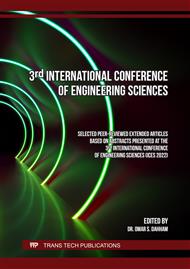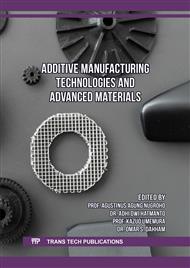[1]
B. Del Sol, G. Parra, R. Peña, A. Salguero. "Study of the Tool Wear Process in the Dry Turning of Al–Cu Alloy", Metals, 2019.
DOI: 10.3390/met9101094
Google Scholar
[2]
W. D. Callister, "Material Science &Engineering: An Introduction", Eight Edition, The University of Utah, 2010.
Google Scholar
[3]
I. Polmear, S. David StJohn, J. Feng-Nie, M. Qian. "Wrought Aluminium Alloys", Elsevier BV, (2017)
DOI: 10.1016/b978-0-08-099431-4.00004-x
Google Scholar
[4]
G. K. Yas "Study of the effect of extract on the mechanical properties of (aluminum - copper) alloy", University of Technology - Master Thesis, 2000.
Google Scholar
[5]
N. J. Mahmood, "The Impact of Adding Copper to Aluminum On Microstructure and Hardness", Al-Qadisiyah Journal For Engineering Sciences, Vol. 8, No. 4, 2015.
Google Scholar
[6]
Sarah Sameer Hussein & Prof. Dr. Nada Mahdi Fawzi,"Influence of Using Various Percentages of Slag on Mechanical Properties of Fly Ash-based Geopolymer Concrete", Journal of Engineering , Number 10 Volume 27 October 2021, http://www.joe.uobaghdad.edu.iq/
DOI: 10.31026/j.eng.2021.10.04
Google Scholar
[7]
F. Alexandre , F. Késsia G. Paradelaa, P. F. Juniora, Z. A. Júniora & A. Garciab, "Phase-Field Simulation of Microsegregation and Dendritic Growth During Solidification of Hypoeutectic Al-Cu alloys", Materials Research. 2017; 20(2): 423-429.
DOI: 10.1590/1980-5373-mr-2016-0194
Google Scholar
[8]
M. Adraa Najeeb, " Effect of Distributing Steel Fibers on Some Properties of Slurry Infiltrated Fiber Concrete", Journal of Engineering , Number 4 Volume 28 April 2022, http://www.joe.uobaghdad.edu.iq/
DOI: 10.31026/j.eng.2022.04.05
Google Scholar
[9]
R. G. Augusto and M. B. da Silva, "Influence of Copper Content on 6351 Aluminum Alloy Machinability", Elsevier, Procedia Manufacturing Volume 1, 2015, Pages 683–695.
DOI: 10.1016/j.promfg.2015.09.014
Google Scholar
[10]
Zahraa Fadhil Muhsin, Prof.Dr. Nada Mahdi Fawzi, "Effect of Fly Ash on Some Properties of Reactive Powder Concrete", Journal of Engineering , Number 11 Volume 27 November 2021, http://www.joe.uobaghdad.edu.iq/
DOI: 10.31026/j.eng.2021.11.03
Google Scholar
[11]
F. Özena, F. Fıçıcı, M. Dündar and M. Çolak , "Effect of Copper Addition to Aluminium Alloys on Surface Roughness in Terms of Turning Operation", ACTA PHYSICA POLONICA A, Vol. 131, No. 3 (2017).
DOI: 10.12693/aphyspola.131.467
Google Scholar
[12]
F. Davis," Aluminum Casting Technology", ASM International, Third Edition, 2017.
Google Scholar
[13]
S. B. Diniz, E. B. Alejandro , A. D. Santos Paula, R. B. Eduardo, "Microstructural evaluation of an asymmetrically rolled and recrystallized 3105 aluminum alloy", Journal of Materials Research and Technology, 2016.
DOI: 10.1016/j.jmrt.2016.02.001
Google Scholar
[14]
V. I. Voronjec, D., M. J. Krane. Microsegregation phenomena in Al-Cu-Mg alloy with considering of diffusion phenomena in primary phase. Series: Mechanical Engineering Vol.1, No 8, p.965 – 980, (2001).University of Texas at AustinFall.
Google Scholar
[15]
M. Asadullah, S. Ito, K. Kunimori, M. Yamada, K. Tomishige. "Energy Efficient Production of Hydrogen and Syngas from Biomass: Development of Low-Temperature Catalytic Process for Cellulose Gasification", Environmental Science & Technology, 2002.
DOI: 10.1021/es020575r
Google Scholar
[16]
L. Dalin, M. Koike, J. Chen & K. Tomishige, "Preparation of Ni–Cu/Mg/Al catalysts from hydrotalcite-like compounds for hydrogen production by steam reforming of biomass tar", International Journal of Hydrogen Energy, Volume 39, Issue 21, 15 July 2014, Pages 10959-10970.
DOI: 10.1016/j.ijhydene.2014.05.062
Google Scholar
[17]
D. William,J. Callister, &G. DAVID ," Materials Science And Engineering An Introduction", 9th Edition,2014.
Google Scholar
[18]
MatWeb.com, Material Property Data, 2019.
Google Scholar
[19]
"Proceedings of the 8th Pacific Rim International Congress on Advanced Materials and Processing", Springer Nature, 2016.
Google Scholar
[20]
R. Huang,.. Web site. Dept of Aerospace Engineering and Engineering Mechanics, (2003).The University of Texas at Austin Fall.
Google Scholar
[21]
A. M. Hassan , O. Bataineh &A. Abed, "The effect of time and temperature on the precipitation behavior and hardness of Al–4 wt. % Cu alloy using design of experiments", Journal of Materials Processing Technology , 204(1):343-349 , August 2008.
DOI: 10.1016/j.jmatprotec.2007.11.047
Google Scholar



